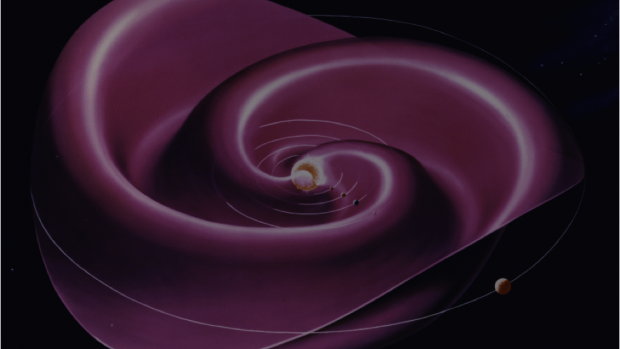
The solar wind continuously flows outward from the Sun and consists mainly of protons and electrons in a state known as a plasma. Solar magnetic field is embedded in the plasma and flows outward with the solar wind.
Different regions on the Sun produce solar wind of different speeds and densities. Coronal holes produce solar wind of high speed, ranging from 500 to 800 kilometers per second. The north and south poles of the Sun have large, persistent coronal holes, so high latitudes are filled with fast solar wind. In the equatorial plane, where the Earth and the other planets orbit, the most common state of the solar wind is the slow speed wind, with speeds of about 400 kilometers per second. This portion of the solar wind forms the equatorial current sheet.
During quiet periods, the current sheet can be nearly flat. As solar activity increases, the solar surface fills with active regions, coronal holes, and other complex structures, which modify the solar wind and current sheet. Because the Sun rotates every 27 days, the solar wind becomes a complex spiral of high and low speeds and high and low densities that looks like the skirt of a twirling ballerina (see figure). When high speed solar overtakes slow speed wind, it creates something known as a corotating interaction region. These interaction regions consist of solar wind with very high densities and strong magnetic fields
Above the current sheet, the higher speed solar wind typically has a dominant magnetic polarity in one direction and below the current sheet, the polarity is in the opposite direction. As the Earth moves through this evolving ballerina skirt, it is sometimes within the heliospheric current sheet, sometimes above it and sometime below it. When the magnetic field of the solar wind switches polarity, it is a strong indication that Earth has crossed the current sheet. The location of the Earth with respect to the current sheet is important because space weather impacts are highly dependent on the solar wind speed, the solar wind density, and the direction of the magnetic field embedded in the solar wind.
Each of the elements mentioned above play a role in space weather. High speed winds bring geomagnetic storms while slow speed winds bring calm space weather. Corotating interaction regions and to a lesser extent, current sheet crossings, can also cause geomagnetic disturbances. Thus specifying and forecasting the solar wind is critical to developing forecasts of space weather and its impacts at Earth.
Image courtesy of NASA